Advertisements
Advertisements
Question
Complete the following table:
| Instrument | Number of Convex Lenses |
Use |
| Simple Microscope | .............. | .............. |
| Compound Microscope | .............. | .............. |
| Telescope | .............. | .............. |
Solution
| Instrument | Number of Convex Lenses |
Use |
| Simple Microscope | 1 | Used by watch repairers to view tiny watch parts |
| Compound Microscope | 2 | Used by watch repairers to view tiny watch parts |
| Telescope | 2 | Used to view faraway objects in outer space |
APPEARS IN
RELATED QUESTIONS
"A convex lens can form a magnified erect as well as magnified inverted image of an object placed in front of it." Draw ray diagram to justify this statement stating the position of the object with respect to the lens in each case.
If you focus the image of a distant object, whose shape is given below, on a screen using a convex lens, the shape of the image of this object on the screen would be:
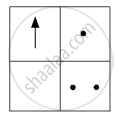
(a)
(b)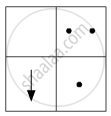
(c)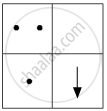
(d)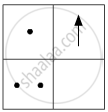
A beam of light travelling in a rectangular glass slab emerges into air. Draw a ray-diagram indicating the change in its path.
A ray of light travelling in air is incident on a parallel-sided glass slab (or rectangular glass slab). Draw a ray-diagram indicating the change in its path in glass.
Draw a labelled ray diagram to show how a ray of light passes through a parallel sided glass block:
if it hits the glass block at an angle other than 90° (that is, obliquely to the glass block).
If an object is placed at the focus of a convex lens, where is the image formed?
What is a lens?
Explain with the help of a diagram, why the convex lens is also called a converging lens.
In order to obtain a real image twice the size of the object with a convex lens of focal length 15 cm, the object distance should be:
(a) more than 5 cm but less than 10 cm
(b) more than 10 cm but less than 15 cm
(c) more than 15 cm but less than 30 cm
(d) more than 30 cm but less than 60 cm
Describe the nature of image formed when an object is placed at a distance of 30 cm from a convex lens of focal length 15 cm.
An object 4 cm high is placed at a distance of 10 cm from a convex lens of focal length 20 cm. Find the position, nature and size of the image.
Find the position and nature of the image of an object 5 cm high and 10 cm in front of a convex lens of focal length 6 cm.
A convex lens of focal length 0.10 m is used to form a magnified image of an object of height 5 mm placed at a distance of 0.08 m from the lens. Calculate the position, nature and size of the image.
A convex lens of focal length 15 cm produces a magnification of +4. The object is placed:
(a) at a distance of 15 cm
(b) between 15 cm and 30 cm
(c) at less than 15 cm
(d) beyond 30 cm
What type of images can a convex lens make?
What kind of lens is used to correct
long-sightedness?
In figure , name the ray which represents the correct path of light while emerging out through
a glass block.
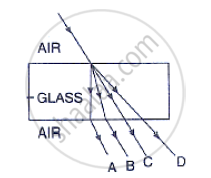
A parallel oblique beam of light falls on a convex lens. Draw a diagram to show the refraction of light through the lens.
A lens forms an upright and magnified image of an object. Name the lens.
In the following cases, where must an object be placed in front of a convex lens so that the image formed is of the same size as the object?
In the following cases, where must an object be placed in front of a convex lens so that the image formed is upright and enlarged?
Analyse the following observation table showing variation of image-distance (v) with object-distance (u) in case of a convex lens and answer the questions that follow without doing any calculations:
| S. No. | Object-Distance u (cm) |
Image-Distance v (cm) |
| 1 | –60 | +12 |
| 2 | –30 | +15 |
| 3 | –20 | +20 |
| 4 | –15 | +30 |
| 5 | –12 | +60 |
| 6 | –9 | +90 |
(a) What is the focal length of the convex lens? State reason for your answer.
(b) For what object-distance (u) is the corresponding image-distance (v) not correct? How did you arrive at this conclusion?
(c) Choose an appropriate scale to draw a ray diagram for the observation at S. No. 4 and find the approximate value of magnification.
If you are to determine to focal length of a convex lens, you should have
(A) a convex lens and a screen
(B) a convex lens and a lens holder
(C) a lens holder, a screen holder and a scale
(D) a convex lens, a screen, holder for them and a scale
Observe the following figure and answer the questions.
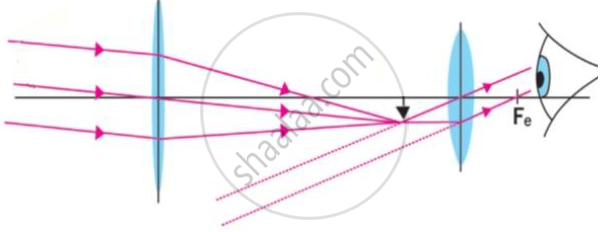
a) Which optical instrument shows arrangement of lenses as shown in the figure?
b) Write in brief the working of this optical instrument.
c) How can we get different magnifications in this optical instrument?
d) Draw the figure again and labelled it properly
Yesh find out F1 and F2 of symmetric convex lens experimentally then which conclusion is true.
Where should an object be placed in front of a convex lens to get a real image of the size of the object?
Answer the following question.
List four precautions which a student should observe while determining the focal length of a given convex lens by obtaining an image of a distant object on a screen.
How will you decide whether a given piece of glass is a concave lens, convex lens, or a plane glass plate?
State the position of object, position of image, nature of image when: Convex lens is used in cine projector.
State the position of object, position of image, nature of image when: Convex lens is used in observing biological specimens.
Write the three characteristics of the image formed by a convex lens of focal length 20 cm for the object at distance (i) 10 cm, (ii) 30 cm, (iii) 40 cm, (iv) 60 cm from the lens.
Which lens can produce a real and inverted image of an object?
Define the principal focus of a convex lens.
Which of the following statements is true?
- In which type of microscope do you find the lens arrangement as shown in the following diagram?

- Write about the working and the use of this microscope.
 |
 |
The above images are that of a specialized slide projector. Slides are small transparencies mounted in sturdy frames ideally suited to magnification and projection since they have a very high resolution and a high image quality. There is a tray where the slides are to be put into a particular orientation so that the viewers can see the enlarged erect images of the transparent slides. This means that the slides will have to be inserted upside down in the projector tray.
To show her students the images of insects that she investigated in the lab, Mrs. Iyer brought a slide projector. Her slide projector produced 500 times enlarged and inverted image of a slide on a screen 10 m away.
a. Based on the text and data given in the above paragraph, what kind of lens must the slide projector have?
b. If v is the symbol used for image distance and u for object distance then with one reason state what will be the sign for `"𝑣"/"𝑢"` in the given case?
c. A slide projector has a convex lens with a focal length of 20 cm. The slide is placed upside down 21 cm from the lens. How far away should the screen be placed from the slide projector’s lens so that the slide is in focus?
OR
c. When a slide is placed 15 cm behind the lens in the projector, an image is formed 3 m in front of the lens. If the focal length of the lens is 14 cm, draw a ray diagram to show image formation. (not to scale)
Distinguish between Concave lens and Convex lens.
